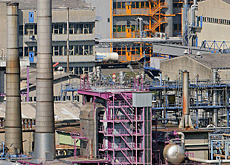
Syngenta agrees to payouts to cancer victims

Agrochemicals firm Syngenta has agreed to give payments to 11 former employees of an insecticide factory in southwestern Switzerland.
According to the Unia trade union, which described the deal as “exemplary”, Syngenta is also giving SFr250,000 ($208,950) for cancer prevention programmes.
Both sides have agreed to withhold details of the payouts to employees, however.
The agreement comes more than a year after reports of a number of cases of bladder cancer around the southwestern town of Monthey that could be connected to exposure to the chemical galecron.
The facility where the active ingredient chlordimeform was produced from 1966 to 1976 and from 1978 and 1988 was owned by Ciba-Geigy before it was sold to Basel-based Syngenta six years ago.
Off the market
The insecticide is believed to have toxic effects on individuals exposed to it. It was taken off the market because of potential risks to users.
A trade union official said nine former employees who suffer from bladder cancer were granted a “considerable one-off payment”. The families of two other employees who have died will also receive funds.
Any future cases that are recognised by the Swiss Accident Insurance Fund will also receive the appropriate indemnity.
The official added that while Syngenta had agreed to the financial compensation there was no scientifically-proven link between the chemicals and the occurrence of cancer.
“The group has committed itself out of respect for the employees,” said Rolf Furter, in charge of product development at Syngenta, adding that it was looking for a swift solution.
Both sides also agreed on Wednesday to continue programmes aimed at raising awareness and preventing the development of cancers, with Syngenta devoting SFr250,000.
A local urologist was quoted as saying that there had been 30 suspicious deaths from bladder cancer in the Monthey region over the past 20 years. He admitted that his evaluation could not be backed up by any statistics.
Last year the director of the Syngenta factory said the company was aware of the suspicions and was pursuing a health-screening programme for employees.
swissinfo with agencies
The merger of Switzerland’s Ciba-Geigy and Sandoz gave birth to a number of new companies.
The biggest is Novartis, which is specialised in pharmaceuticals.
At the end of 1999, Novartis’s agrochemicals business was merged with a division of the British-Swedish concern, Astra Zeneca, to become Syngenta.
Ciba Speciality Chemicals merged the fine-chemicals divisions of Ciba-Geigy and Sandoz.
Galecron, which contains the active ingredient chlordimeform, was an insecticide produced by Ciba-Geigy, widely used in agriculture, mainly horticulture and rice farming.
Galecron was made in a factory in the Swiss town of Monthey, as well as in Britain and in the United States.
The Monthey facility produced the active ingredient from 1966 onwards, including a two-year break for safety assessments in the 1970s. Production was halted permanently in 1988 after more research showed potential risks.
From that date onwards, the company closely monitored the health of its employees who had been involved in the production of the galecron.

In compliance with the JTI standards
More: SWI swissinfo.ch certified by the Journalism Trust Initiative




























You can find an overview of ongoing debates with our journalists here . Please join us!
If you want to start a conversation about a topic raised in this article or want to report factual errors, email us at english@swissinfo.ch.